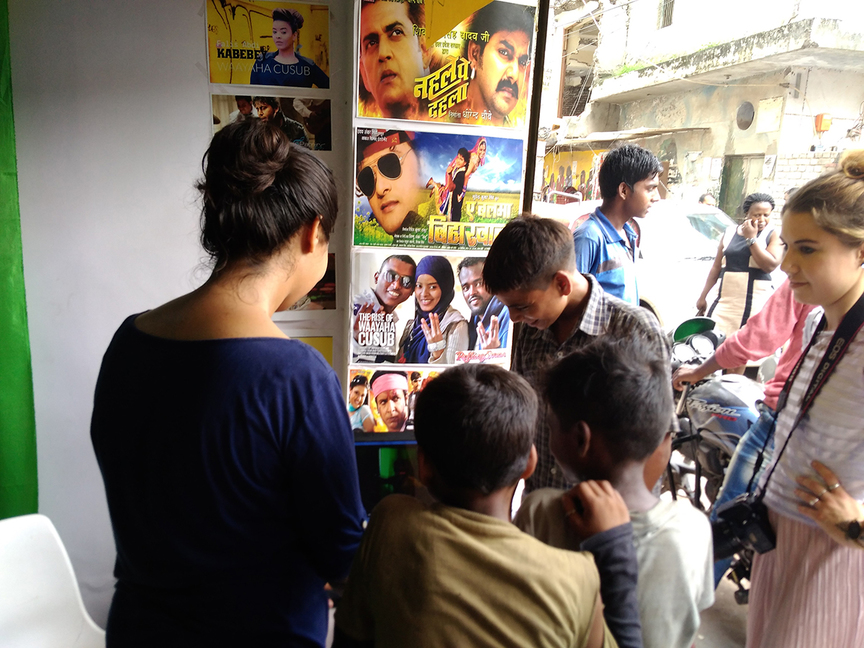
R
E
V N
E
X
T
The Khirkee Storytelling Project is an umbrella for a range of media-sharing and community broadcast activities, including Khirkee Talk Show. All images courtesy Khirkee Storytelling Project.
“I like cities,” the architect and artist Swati Janu told me; “I think of them as living organisms, beasts really, life throbbing through the many layers and intricate, interlinked networks.” Like the body of any beast, cities adapt to their circumstances, and New Delhi, where Janu created the Khirkee Storytelling Project, is no exception. Since mobile and smart phones have become available in India, the phenomenon of the neighborhood recharge shop has arisen to meet demand for top-up credit in urban areas. However, this isn’t all such places do. They also act as nodes in a network of pirate media distribution, selling movies for around INR 10 (USD 0.15), or 2GB of songs for INR 40 (USD 0.62).
Following a residency at New Delhi’s Khoj International Artists’ Association, with which Janu shares a keen interest in community engagement, she became fascinated with the diversity of media that circled through the massively vibrant Khirkee neighborhood, where the center is based. Classed as an unauthorized colony, and home to post-Partition refugees who act as landlords to often itinerant tenants, including workers from Bihar, students from all over India, refugees from Somalia and Afghanistan, and immigrants from Russia, Nepal, Nigeria, the Ivory Coast, Uganda, the Democratic Republic of Congo, and elsewhere, Khirkee has a rich and dynamic culture and community, the lifeblood of which is, in many ways, the media that its residents introduce, consume and share.
Khirkee residents at a community screening, one of the many forms of media exchange organized through the Khirkee Storytelling Project.
Janu came to think of the entrepreneurial owners of these recharge shops—who would suggest media to customers, and even compile lists based on trends and local demand—as both media curators and technological intermediaries, helping locals to bridge the gap between the physical and digital worlds not just by channelling media, but also by sharing knowledge, such as how to set up a Facebook account. She began to ask these vital if understated figures to teach her the skills of their trade and, before long, the Khirkee Recharge Shop, from which the Storytelling project would develop, was born. Renting out a small hole-in-the-wall shop—the kind from which a plethora of businesspeople in the Indian capital ply their diverse trades—Janu set up a store with a difference. Instead of charging money for top-ups, videos and music, she asked that customers pay with their choice of media from their phones, and thus began to create a self-sustaining archive, mapping the culture and tastes of a community. Janu not only learned about the different genres of media moving in the community—from Hindi movies dubbed in Somalian to bewafai ke gaane, or “songs of heartbreak”—but also facilitated their circulation.
At first, the majority of “customers” were male Bihari workers (Janu regrets that, due to the public nature of the project and conservative attitudes in parts of the neighborhood, hardly any women could participate); however, before long, Somali, Afghan, Nigerian, Congolese and South African residents, who were generally economically better off and able to download media by other means, began bringing music and movies on USB drives purely with the intention of sharing. This not only revealed some interesting cultural connections, such as the presence of Punjabi rhythms in various African pop music, but also helped to create new ones in this melting pot community.
As the Khirkee Recharge Shop began to take on a life of its own, Janu moved it into a new and exciting second phase that would make the residents of the neighborhood not merely consumers of content, but creators. Staying on theme, and using mobile phones as recording and editing devices, Janu and a now growing team turned the shop into a low-budget recording studio complete with makeshift green-screen curtains in which members of the community could record audio and video. Providing a subversive alternative to the regional broadcasting that often ignores urban communities such as this, visitors used the space to tell personal stories in segments such as Khirkee Talk Show. There was also a growing interest in performance, with residents dropping in to record songs and share their talents, and rap becoming the dominant form. The content created comprises several performances by local hip-hop collective Khirkee 17, and other works in languages including Bhojpuri, Hindi, Punjabi, Ivory Coast French and English.
Spanning only one year, in its own small way, the Khirkee Storytelling Project was a model example of community-focused work done well. The project seamlessly and unobtrusively integrated into a previously existing infrastructure, and then advanced this infrastructure to allow for creative, independent exchange rather than top-down distribution. The Recharge Shop and its archive of media allowed Janu to record the intersecting cultures of a community, while also giving that community the means to redraw the map for themselves.
Ned Carter Miles is the London desk editor of ArtAsiaPacific.
To read more of ArtAsiaPacific’s articles, visit our Digital Library.






